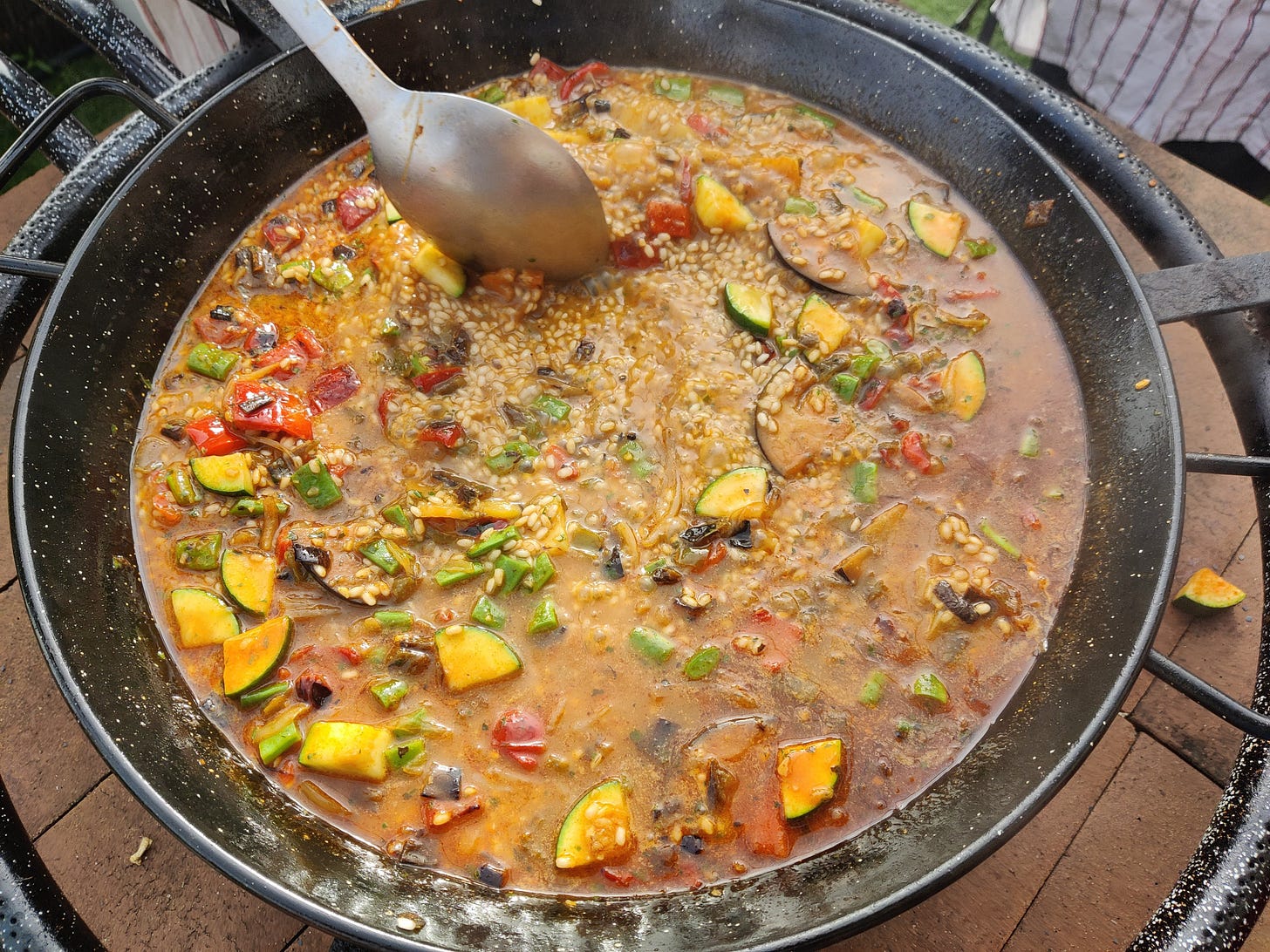Looking Forward… & Back
Key challenges for food systems in 2025 and beyond
We’re only 10 days into a new year and already seeing: warnings of widening famine in Sudan, the deaths of at least six dozen children in the Gaza Strip (where aid workers say famine has also taken hold but politicking has kept it from being declared) and one of the most expensive wildfire disasters in U.S. history.
I haven’t even touched on the complete and utter mess that is likely to come with a climate-denying, vaccine-badmouthing, food-aid-cutting administration.
I’m sorry to start the first issue of 2025 in stark contrast to the last issue of 2024, but ignoring the bad news around us would be a complete dereliction of duty.
Is it a harbinger of things to come? I don’t know, but it’s hard not to feel like someone somewhere is trying to tell us something. Something akin to Bill McKibben’s New Yorker piece in 2022, “In a world of fire, stop burning things”.
Will we change from our self-destructive course? Again, I don’t know, but I want to be part of the discourse on what we can do and how we can change. So I’m gonna reiterate something I mentioned in my last issue: I’m looking to commission food systems stories and musings in 2025. I’m offering 300 Euros per 2,000-word piece. If you have ideas, please drop me a line.
Looking forward
I got the idea for this issue while preparing for an online lecture last October where I was asked to talk about the current challenges and debates in food systems.
My first thought was, “Oh my god, where do I start? There’s so much to talk about!” There are also many ways to slice and dice the myriad of topics under these big themes. But then I backed up, thought some more, and came up with something.
I decided to strip it down to three key - and cross-cutting - challenges that we need to tackle, not just in 2025 but beyond: how to make our food systems (1) healthier, (2) greener, (3) and fairer.
Key context (1): Food systems can play a key role in tackling the triple planetary crisis of climate change, biodiversity loss, and air pollution, because food systems are also key drivers of all three.
But to do that we need to go beyond the productivist mindset and the immediate-but-narrow confines of food insecurity. We need to look at it at a systems level.
Key context (2): Over the past half a century, food production jumped by 300%, meat production more than tripled, and the production and consumption of fish and seafood hit an all-time high.
Yet hunger and malnutrition persist: in fact we are heading in the wrong direction, with 1 in 11 people going to bed hungry in 2023, 1 in 3 unable to afford healthy diets, and 1 in 6 adults obese in 2022, from 1 in 8 in 2012.
What these data show is that (1) modern-day hunger and malnutrition is not about whether we have enough food, and (2) there’s something seriously wrong about our current food systems.
“Unequal relationships and power dynamics in markets, in households, and in policy processes, determine who has access to resources and who does not, shaping who is hungry and malnourished and who is not.” (U.N. Food Systems Summit)
Challenge 1: “What we’re eating is killing us.”
These words from Jessica Fanzo during an interview in 2018 opened my eyes and have stayed with me ever since.
Non-communicable diseases (NCDs) are the number 1 cause of death and disability worldwide, leading to about 41 million deaths every year. Bad diets are a key culprit.
In 2021, 10.6% of all deaths globally and 30% of deaths from cardiovascular diseases were associated with poor diets, said the Institute for Health Metrics And Evaluation (IHME). Sugary drinks kill 34,000 a year (see the NYT piece in Thin’s Pickings).
It’s not all about death though. Unhealthy food systems are also why we have millions of people who are overweight, obese, and/or deficient in critical micronutrients such as iron, zinc, and calcium that are essential for the proper functioning of our bodies.
Our food systems have hidden costs too: a whopping $11.6 trillion in 2020, according to the FAO’s latest calculations. Health costs related to NCDs account for a staggering two-thirds (70%).
If you break that down further, you get the top three risks: diets low in wholegrain (18%), diets high in sodium (16%) and diets low in fruits (16%).
We need to have more diverse diets. Currently, three crops alone - rice, wheat, and maize - make up more than 40% of our daily calories.
We also need our governments to shift subsidies away from energy-rich crops to nutrient-rich foods, and expand the focus beyond yields per hectare.
Change is all the more important and necessary because we now know that climate change is going to affect both the quantity and quality of food we can grow.
Challenge 2: “An unhappy marriage with an addiction problem.”
Our current food systems account for a third of total manmade greenhouse gas emissions that are heating up our planet, so unless we change the way we grow, harvest, transport, process, store, consume, and discard food, we can kiss goodbye to a liveable future and say hello to more crazy weather.
The largest contribution - 71% - comes from agriculture and land use/land-use change activities (deforestation, degradation of organic soils) and the rest from supply chain activities. The contribution of the latter is expected to grow.
There are emissions associated with almost all parts of the food value chain.
Let’s start with the farm, where we release three key GHGs - CO₂, CH₄, N₂O - depending on what is grown and how it is grown. You need diesel to operate farm machinery and transport produce (CO₂). If you have livestock, burps and manure emit methane (CH₄). So do flooded rice fields. Use of fertiliser causes nitrous oxide (N₂O). Fossil fuels are also used to produce fertilisers and pesticides.
There are similar emissions for fisheries. You need oil to run fishing vessels and/or fish farms. Getting raw materials, processing them into feed, and transporting them all requires fossil fuels. Organic fish waste can also release CH₄ and N₂O.
Methane accounts for around 35% of food-system emissions mainly due to livestock production, farming (particularly rice farming) and waste treatment.
You then have emissions from beyond the farm: transportation, processing, packaging, storage, consumption, and food loss and waste. But GHG emissions are just one aspects of how our food systems are environmentally destructive.
Agriculture is a primary driver of biodiversity loss and a key threat to 86% of species at risk of extinction, according to UNEP. It is also the largest user of freshwater and takes up 50% of global habitable land.
The use of chemical fertilisers and pesticides, plastics, and antibiotics also cause pollution of air, water, and soil, which in turn lead to acidification and eutrophication that endanger both human and animal health.
We need to seriously rethink how we grow our food. We need to stop the overuse and misuse of synthetic inputs, if stopping completely is impossible.
Those of us in the Global North also need to cut down our meat intake, particularly beef. Growing feed for cows is a major strain on our land and water resources and encourages the use of chemicals, and it is well-documented that expanding cattle farming into natural habitats destroys our ecosystems.
Challenge 3: Power to the people
I personally see this as the most important but also the most difficult challenge. The structural inequalities, the power imbalances, and the lack of fairness in our food systems are why they’re deadly and environmentally destructive.
At a very basic level, our current food systems are unfair because a handful of corporations and a minuscule percentage of the global population reap the benefits while the vast majority of us are poor, hungry, and having to bear the brunt of climate change. Farmers and food systems workers who feed the world are some of the poorest paid people in the world.
There are also many, many layers to this: inequalities between consumers and companies, between governments and companies, between rich and poor nations, between exporting and importing countries, between farmers and companies, between big and small farmers, between food systems works and employers, and between genders, races, and income levels.
For example, the costs of food imports are placing an increasing burden on some of the world’s poorest - and hungriest - countries. Projections by the United Nations Economic Commission for Africa showed annual expenses increasing by a factor of seven from $15 billion in 2018 to $110 billion by 2025.
And if you read the two Reuters investigations below cited in Thin’s Pickings, you’ll clearly see that the power imbalances are actually killing people.
One of the biggest problems is that our food systems have become incredibly concentrated and consolidated. Here’s a small rundown based on statistics from Farm Action 2024 and Food Barons 2022.
Food trade: ABCDs (Archer Daniels Midland, Bunge, Cargill, and Louis Dreyfus) estimated to account for 70% of global food trade.
Seeds: 4 companies own 51% of the market (Bayer: 23%, Corteva: 17%, ChemChina: 7%, BASF: 4%)
Agrochemicals: 4 companies own 62% (ChemChina: 24.6%, Bayer: 16%, BASF: 11.3%, Corteva: 10.4%)
Poultry genetics: 3 companies control commercial poultry genetics (EW Group, Hendrix Genetics, Tyson Foods)
We all know that monopolies and oligopolies tend to result in ordinary people losing out, whether it’s for food or tech or other consumer products. They can set prices, they can decide which products to focus on, usually the ones that yield the most profits, not necessarily the most resilient or most suitable, and their market power gives them access to decision-makers.
There is a big fight brewing around the ability of farmers to save their seeds - an age-old tradition in the Global Majority - and the clamour from corporations using intellectual property rights to restrict that practice. It is also linked to the furious disagreements between rich nations and corporations and poor countries over the sharing profits from genetic resources.
The blaming and shaming of consumers - for not eating the right things or living the right life - will continue, and any attempts to rein in Big Food for the benefit of people and planetary health will be turned into a culture war about personal freedoms and nanny states. But as this refreshing report from the WHO showed, that whole narrative about choice is a con. Let’s not buy into it anymore.
Over the past two years, my colleagues and I at Lighthouse Reports’ Food Systems Newsroom have exposed many of these inequalities:
the conduct of powerful farm lobbies that stymie the EU’s green agenda but are not representative,
efforts to downplay the risks of pesticides and discredit environmentalists,
EU-banned pesticides being used in poorer, non-European nations, and,
excessive speculation bringing windfalls to funds but hunger to ordinary people.
Colleagues in many other newsrooms around the world have also covered these issues, and all of us are determined to continue this work.
The need for a more just and fair food systems is going to become even more important and fraught as climate change bites, our health deteriorate, and billionaire tech bros in cahoots with despotic regimes happily allow lies and hate speech to spread. We all have a role to play, however big or small, in holding the powerful accountable.
I’m fully aware that not everyone has the time, resources, or the opportunity to keep up with what feels like a never-ending struggle. That is precisely why those of us who do have them are privileged and we need to keep fighting.
That’s my resolution for 2025.
Remember: if we give up, they win.
Looking back
That mantra was something I pushed repeatedly throughout most of the year, beginning with this issue in February, and that segues nicely into some reflections of the past year, a year of learning and renewal.
I learnt the importance of deep breaths and taking things as they come at the start of the year when my bag got snatched and I unwittingly got stuck in London.
I discovered how far I could push myself physically and mentally, nearly reached my limit, and don’t ever want to approach there ever again.
I got inspired by some heroes (note: this is not an exhaustive list):
Leonardo the Dutch farmer who’s doing all he can to adopt sustainable farming practices despite massive challenges (see under “Why we can’t give up (1)”,
Belgian livestock farmer Hugues Falys who filed a lawsuit against TotalEnergies,
Austrian Environment Minister Leonore Gewessler who cast the deciding vote on the Nature Restoration Law (see under “Going Rouge),
The Burmese folks in Thailand doing all they can under incredibly difficult circumstances
My soul was nourished by these writers and thinkers:
Robin Wall Kimmerer’s Braiding Sweetgrass, which inspired this issue of Thin Ink (the book was a gift from a friend while I was stranded in London so yes, a few good things indeed came out of that trip)
John Amaechi, especially his thoughts in this conversation
Pamela Swanigan’s sharp and though-provoking piece about “the long defeat”
I hope to bring these knowledge and ideas and inspirations into the new year.
Thin’s Pickings
4 Graphics Explain Los Angeles’ Rare and Devastating January Fires - World Resources Institute
Some of us have been watching with horror what’s happening in California, and this pithy piece from WRI explains the underlying trends that make these fires possible. The future looks fiery, my friends.
Myanmar junta intimidates aid groups in effort to hide hunger crisis - Reuters
Reuters has published some really good investigations into hunger in conflict zones. This one said the military junta pressured aid workers and food-security researchers from revealing that Myanmar “was facing one of the worst food crises on the planet”.
The news agency said it “also uncovered at least four examples of how the junta blocked aid distribution or seized food supplies intended for the hungry”, including in Rakhine, one of Myanmar’s poorest states with a high level of hunger and malnutrition and home to the persecuted Rohingya Muslim monitory group.
As Gaza suffers, hunger watchdog refrains from using the F word: famine - Reuters
Devastating report on the increasing number of children dying of malnutrition-related issues in Gaza, which experts believe is a sign that famine has already taken hold. Yet the world’s hunger monitor has not declared it as such because it lacks access to key data.
While the situation is rightly raising questions about the definition of famine, what’s truly flabbergasting and infuriating is the U.S.’s attempts to downplay the situation and how they got away with it.
Why is the American diet so deadly? - The New Yorker
A great long read from Dhruv Khullar into the research and debate on ultra-processed foods. Best taken with a cup of tea on a Sunday morning.
Diabetes and Heart Disease Rise Alongside Sugary Drink Consumption - The New York Times
About 34,000 deaths a year. Plus “2.2 million additional cases of Type 2 diabetes and 1.2 million cases of cardiovascular disease in 2020”, mostly in sub-Sharan Africa and Latin America.
That’s the cost of consuming sugary drinks which includes “carbonated soda, energy drinks and juices with added sugar”, wrote Andrew Jacobs, citing a study published in Nature.
As always, please feel free to share this post and send tips and thoughts on bluesky @thinink.bsky.social, mastodon @ThinInk@journa.host, my LinkedIn page, or via e-mail thin@thin-ink.net.






